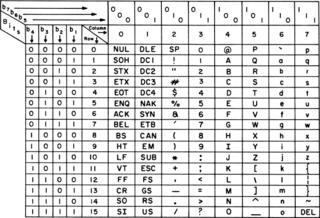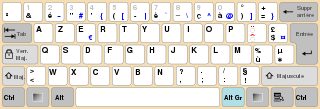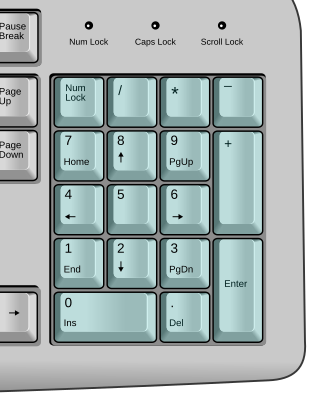
ASCII, abbreviated from American Standard Code for Information Interchange, is a character encoding standard for electronic communication. ASCII codes represent text in computers, telecommunications equipment, and other devices. Because of technical limitations of computer systems at the time it was invented, ASCII has just 128 code points, of which only 95 are printable characters, which severely limited its scope. Modern computer systems have evolved to use Unicode, which has millions of code points, but the first 128 of these are the same as the ASCII set.

Dual-tone multi-frequency signaling (DTMF) is a telecommunication signaling system using the voice-frequency band over telephone lines between telephone equipment and other communications devices and switching centers. DTMF was first developed in the Bell System in the United States, and became known under the trademark Touch-Tone for use in push-button telephones supplied to telephone customers, starting in 1963. DTMF is standardized as ITU-T Recommendation Q.23. It is also known in the UK as MF4.

QWERTY is a keyboard layout for Latin-script alphabets. The name comes from the order of the first six keys on the top letter row of the keyboard. The QWERTY design is based on a layout included in the Sholes and Glidden typewriter sold via E. Remington and Sons from 1874. QWERTY became popular with the success of the Remington No. 2 of 1878, and remains in ubiquitous use.

Viewdata is a Videotex implementation. It is a type of information retrieval service in which a subscriber can access a remote database via a common carrier channel, request data and receive requested data on a video display over a separate channel. Samuel Fedida, who had the idea for Viewdata in 1968, was credited as inventor of the system which was developed while working for the British Post Office which was the operator of the national telephone system. The first prototype became operational in 1974. The access, request and reception are usually via common carrier broadcast channels. This is in contrast with teletext.

Ü is a Latin script character composed of the letter U and the diaeresis diacritical mark. In some alphabets such as those of a number of Romance languages or Guarani it denotes an instance of regular U to be construed in isolation from adjacent characters with which it would usually form a larger unit; other alphabets like the Azerbaijani, Estonian, German, Hungarian and Turkish ones treat it as a letter in its own right. In those cases it typically represents a close front rounded vowel.

A telephone keypad is a keypad installed on a push-button telephone or similar telecommunication device for dialing a telephone number. It was standardized when the dual-tone multi-frequency signaling (DTMF) system was developed in the Bell System in the United States in the 1960s that replaced rotary dialing originally developed in electromechanical switching systems. Because of the installed abundance of rotary dial equipment well into the 1990s, many telephone keypads were also designed to produce loop-disconnect pulses electronically, and some could be optionally switched to produce either DTMF or pulses.

The QWERTZ or QWERTZU keyboard is a typewriter and keyboard layout widely used in Central and Southeast Europe. The name comes from the first six letters at the top left of the keyboard:.

AZERTY is a specific layout for the characters of the Latin alphabet on typewriter keys and computer keyboards. The layout takes its name from the first six letters to appear on the first row of alphabetical keys; that is,. Similar to the QWERTZ layout, it is modelled on the English QWERTY layout. It is used in France and Belgium, although each of these countries has its own national variation on the layout. Luxembourg and Switzerland use the Swiss QWERTZ keyboard. Most residents of Quebec, the mainly French-speaking province of Canada, use a QWERTY keyboard that has been adapted to the French language such as the Multilingual Standard keyboard CAN/CSA Z243.200-92 which is stipulated by the government of Quebec and the Government of Canada.

A keypad is a block or pad of buttons set with an arrangement of digits, symbols, or alphabetical letters. Pads mostly containing numbers and used with computers are numeric keypads. Keypads are found on devices which require mainly numeric input such as calculators, television remotes, push-button telephones, vending machines, ATMs, point of sale terminals, combination locks, safes, and digital door locks. Many devices follow the E.161 standard for their arrangement.

Japanese input methods are used to input Japanese characters on a computer.

Phonewords are mnemonic phrases represented as alphanumeric equivalents of a telephone number. In many countries, the digits on the telephone keypad also have letters assigned. By replacing the digits of a telephone number with the corresponding letters, it is sometimes possible to form a whole or partial word, an acronym, abbreviation, or some other alphanumeric combination.
ISO/IEC 9995Information technology — Keyboard layouts for text and office systems is an ISO/IEC standard series defining layout principles for computer keyboards. It does not define specific layouts but provides the base for national and industry standards which define such layouts.

Romanization of Georgian is the process of transliterating the Georgian language from the Georgian script into the Latin script.
A text entry interface or text entry device is an interface that is used to enter text information in an electronic device. A commonly used device is a mechanical computer keyboard. Most laptop computers have an integrated mechanical keyboard, and desktop computers are usually operated primarily using a keyboard and mouse. Devices such as smartphones and tablets mean that interfaces such as virtual keyboards and voice recognition are becoming more popular as text entry systems.

A PIN pad or PIN entry device is an electronic device used in a debit, credit or smart card-based transaction to accept and encrypt the cardholder's personal identification number (PIN).
The ISO basic Latin alphabet is an international standard for a Latin-script alphabet that consists of two sets of 26 letters, codified in various national and international standards and used widely in international communication. They are the same letters that comprise the current English alphabet. Since medieval times, they are also the same letters of the modern Latin alphabet. The order is also important for sorting words into alphabetical order.

A keyboard layout is any specific physical, visual, or functional arrangement of the keys, legends, or key-meaning associations (respectively) of a computer keyboard, mobile phone, or other computer-controlled typographic keyboard.
ISO 9564 is an international standard for personal identification number (PIN) management and security in financial services.

A numeric keypad, number pad, numpad, or ten key, is the palm-sized, usually-17-key section of a standard computer keyboard, usually on the far right. It provides calculator-style efficiency for entering numbers. The idea of a 10-key number pad cluster was originally introduced by Tadao Kashio, the developer of Casio electronic calculators.













